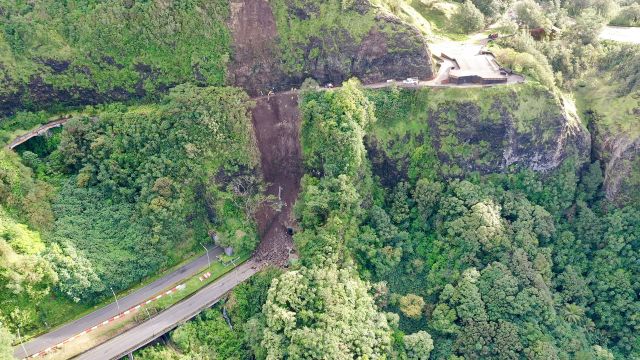Landslides are a common and destructive occurrence in all mountainous areas, but the heavy rains, loose rocks and occasional seismic activity make Hawaii a prime location for treacherous slides. Many remember the catastrophic rockfall, a type of landslide, that struck Oahu’s Sacred Falls on Mother’s Day of 1999, killing 8 people and injuring 50 others. More recently, landslides have closed down roadways on Oahu and Maui, such as the Pali and Honoapiilani Highways, both in February of 2019. With the likelihood of landslides around the islands, it’s important for Hawaii residents to learn the warning signs and how to stay safe.
What are landslides and what causes them?
According to the United States Geological Survey (USGS), a landslide is: “a general term used to describe the downslope movement of soil, rock and organic materials under the effects of gravity and also the landform that results from such movement.”
Landslides can happen anywhere. “Landslides occur in every state of the US, even Florida and Kansas. But they happen everywhere. They are more common though in the mountainous states,” according to Rex Baum, supervisory research geologist with USGS.
Baum explains that many factors can lead to landslides, but heavy rains are one of the most common causes. Rainfall can lead to small, shallow landslides that may transform into debris flows. Steep slopes and frequent rain in Hawaii make this type of landslide particularly pervasive locally.
Earthquakes and seismic activity can also lead to large landslides. Volcanic activity on Hawaii Island leads to earthquakes, such as the 6.9 magnitude May 2018 quake that resulted from reverse faulting in Kilauea. Thankfully, that earthquake wasn’t large enough to trigger a tsunami, but subsequent landslides were recorded in the Hamakua Coast.
Although less frequent in Hawaii, wildfires may also lead to landslides. Fires may clear underbrush in wooded or other areas, which leaves the ground unprotected. “And then rainfall can cause what we call post-fire debris flows which, in the popular media, are usually called mudslides or mudflows,” explains Baum. This type of flow is more common in areas like Southern California and the Western United States.
Not all landslides are natural disasters and may instead be caused by “activities related to construction and earth moving,” notes Baum. “If they cut the toe off of a hill slope, for example, then that can remove some of the mass that buttresses the upper areas allowing them to slide.”
Risks in Hawaii
The USGS has done studies in Hawaii to assess the risks of possible future landslides. They have created several maps to show different risk areas on all islands. You can review the maps to check whether or not your area is in a potentially dangerous region.
Not all landslides in Hawaii are fast-moving. Some may be slow and develop over time, such as those that happened in the Manoa Valley in the 1980s. Warning signs for this type of landslide include cracks in your home or yard. “Sometimes there's uneven settlement. You might start noticing that doors stick or don't swing properly, a window might start to get out of square,” says Baum. “You see this gradual deformation going on to your home and to your property, so those are warning signs of a slow-moving landslide.”
This type of slow-moving slide isn’t usually life-threatening but can cause massive losses in property damage, according to Baum.
Staying safe
Unfortunately, some landslides are unavoidable and can’t be predicted. According to Baum, “the debris flows and rockfalls are the deadlier types of landslides. And you have both of those in Hawaii.” Be careful when hiking or swimming in or near waterfalls, as these areas are more prone to falling debris.
Some warning signs that a landslide may occur include:
- Outdoor structures, like a lanai, tilting away from the house
- New cracks or bulges in a home or its foundation
- New waterflows or streams where they are not usually present
- Tilting trees, fences, telephone poles or other normally upright objects
- Sunken road beds
- Sudden changes in stream water levels
- Rumbling sounds of debris knocking together that get louder as they approach your area
Although it’s hard to prepare for a landslide, keeping an emergency kit is always a good idea in case of any natural disaster. The best practice is to be aware of the threat level in your area and conditions that may cause landslides as they arise. In severe conditions, such as prolonged or heavy rainfall, Baum says, “Evacuation is probably the best if you're in a dangerous spot. Especially if you're in an area where landslides might occur rapidly.”






